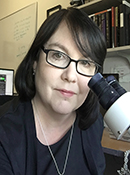Carole LaBonne Stem cells, gene regulatory networks & the evolution of vertebrates
Research Interests
How a single cell ultimately gives rise to a patterned, complex organism is one of the fundamental questions in biology, and one by which scientists and philosophers have been fascinated since the time of Aristotle. We now know that embryonic development is a process in which cells that are initially pluripotent – capable of giving rise to all possible cell types – generate complexity by becoming lineage restricted in a progressive, ordered, and highly robust manner. Interestingly, although the pluripotency of most early embryonic cells is transient, an exception to this loss of potential is a special group of stem cells, called neural crest cells, which are localized to the ectoderm at the neural plate border yet possess broad multi-germ layer developmental potential. Neural crest cells are linked to a large set of birth defects and cancer, thus are of great clinical importance, and their acquisition was the primary event in the evolution of vertebrates. We recently proposed a new hypothesis for the developmental and evolutionary origins of the vertebrate neural crest: that the genetic and epigenetic mechanisms that control the pluripotency of early blastula cells are retained in select cells during gastrulation, and these cells become the neural crest, retaining the multi-germ layer potential of their blastula ancestors. This new framework provides us with a powerful in vivo system to investigate the mechanisms that control pluripotency and lineage restriction.
A longstanding focus of the LaBonne laboratory has been understanding the genesis of neural crest stem cells at the level of the signaling pathways and transcription factors that comprise the neural crest gene regulatory network. More recently it has become clear that the orchestration of these events is highly dependent on chromatin structure and the proteins that control it, deemed “epigenetic” regulatory factors. Accordingly, we utilize powerful genomic (RNA Seq, ChiP Seq), proteomic, biochemical and embryological approaches to investigate the genetic and epigenetic control of pluripotency in early blastula cells and how this developmental potential is retained in the cells that will become the neural crest. We also study how these mechanisms contribute to exit from pluripotency and the subsequent lineage restriction of neural crest cells to their derivative cell types that collectively define vertebrates. Finally, our recent discovery that the response of early embryonic cells to some chemical inhibitors of epigenetic regulatory factors varies greatly on a cell by cell basis has led us to take our mechanistic studies to signal cell resolution in order to understand how stochastic cell-cell differences in gene activity might help drive embryonic decision-making.
Selected Publications
Small molecule-mediated reprogramming of Xenopus blastula stem cells to a neural crest state. Hauber PB and LaBonne C. Developmental Biology. 2024 January;505:34-41.
BET activity plays an essential role in control of stem cell attributes in Xenopus. Huber PB, Rao A, and LaBonne C. Development. 2024 July 1;151(13):dev202990.
SoxB1 transcription factors are essential for initiating and maintaining neural plate border gene expression. Schock EN, York JR, Li AP, Tu AY, and LaBonne C. Development. 2024 July 15;151(14):dev202693.
Shared features of blastula and neural crest stem cells evolved at the base of vertebrates. York JR, Rao A, Huber PB, Schock EN, Montequin A, Rigney S, LaBonne C. Nat. Ecol. Evol. 2024 July 26;Online ahead of publication.
Histone deacetylase activity has an essential role in establishing and maintaining the vertebrate neural crest. Rao A and LaBonne C. Development. 2018 August 8;145(15):dev163386.
FGF mediated MAPK and PI3K/Akt Signals make distinct contributions to pluripotency and the establishment of Neural Crest. Geary L and LaBonne C. eLife. 2018 January 19;7:e33845.
Modeling human development and disease in Xenopus. LaBonne C and Zorn AM. Developmental Biology. 2015 December 15;408(2):179.
Shared regulatory programs suggest retention of blastula-stage potential in neural crest cells. Buitrago-Delgado E, Nordin K, Rao A, Geary L, and LaBonne C. Science. 2015 June 19;348(6241):1332-1335.
View all publications by Carole LaBonne listed in the National Library of Medicine (PubMed). Current and former IBiS students in blue.
